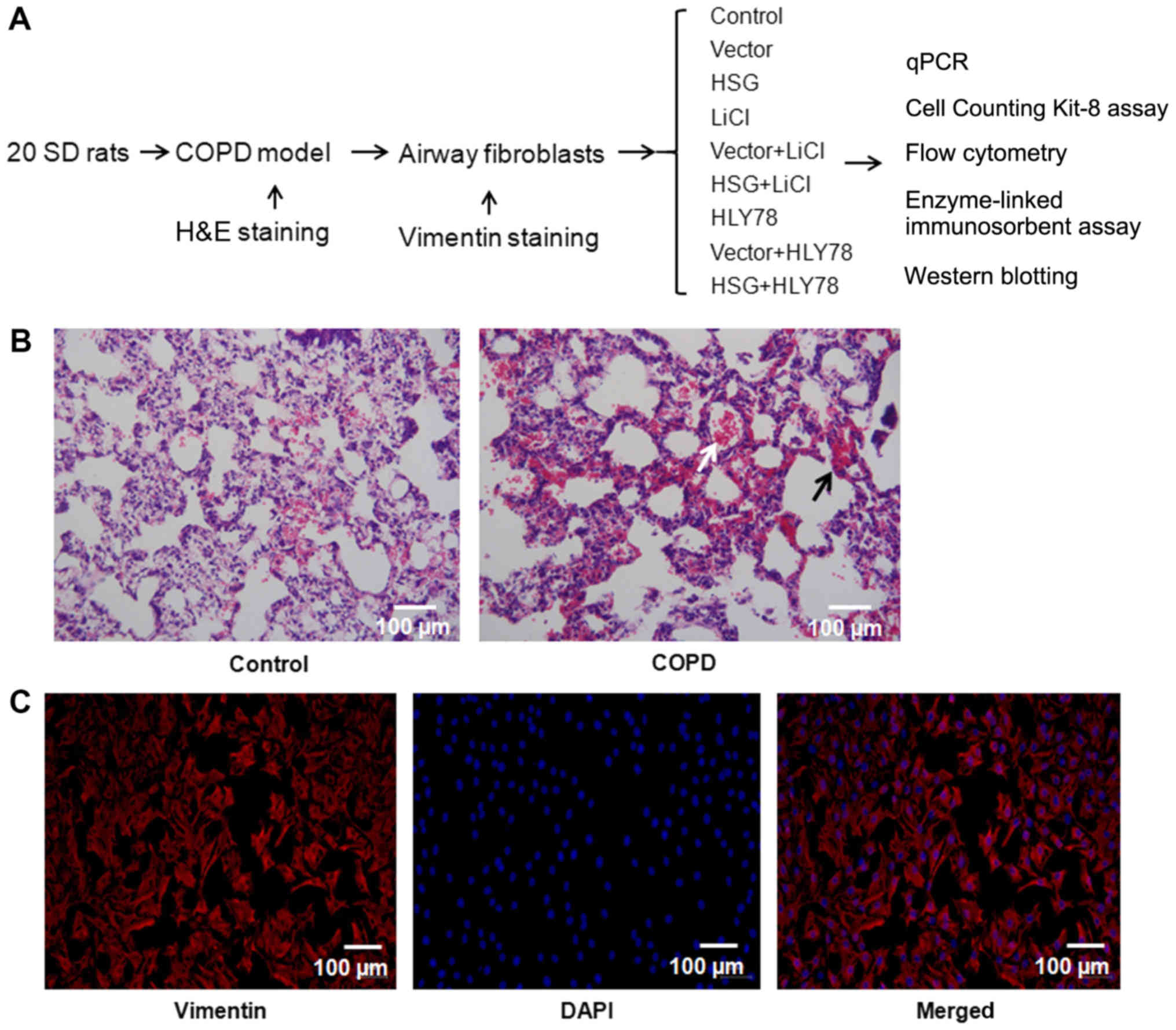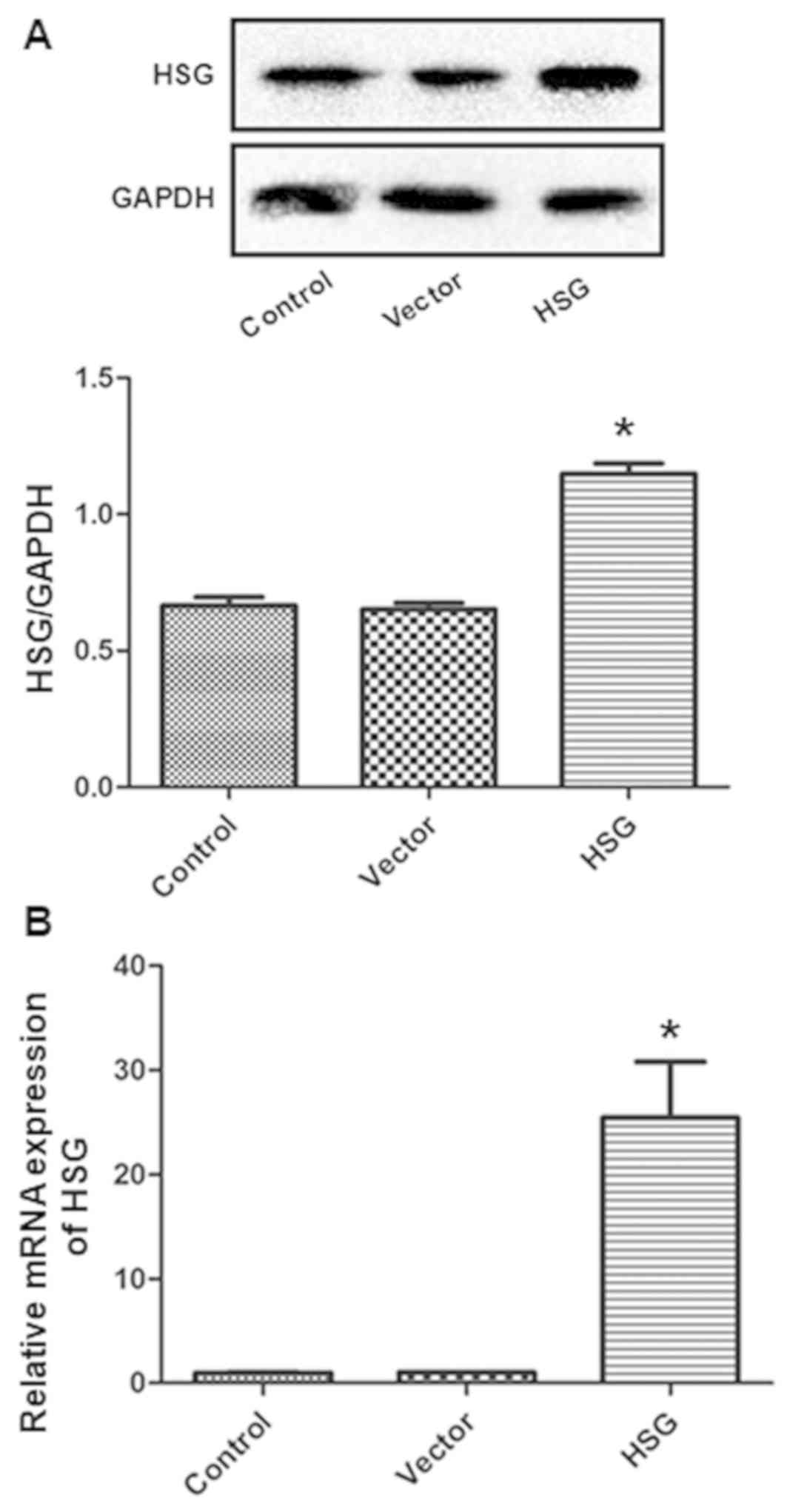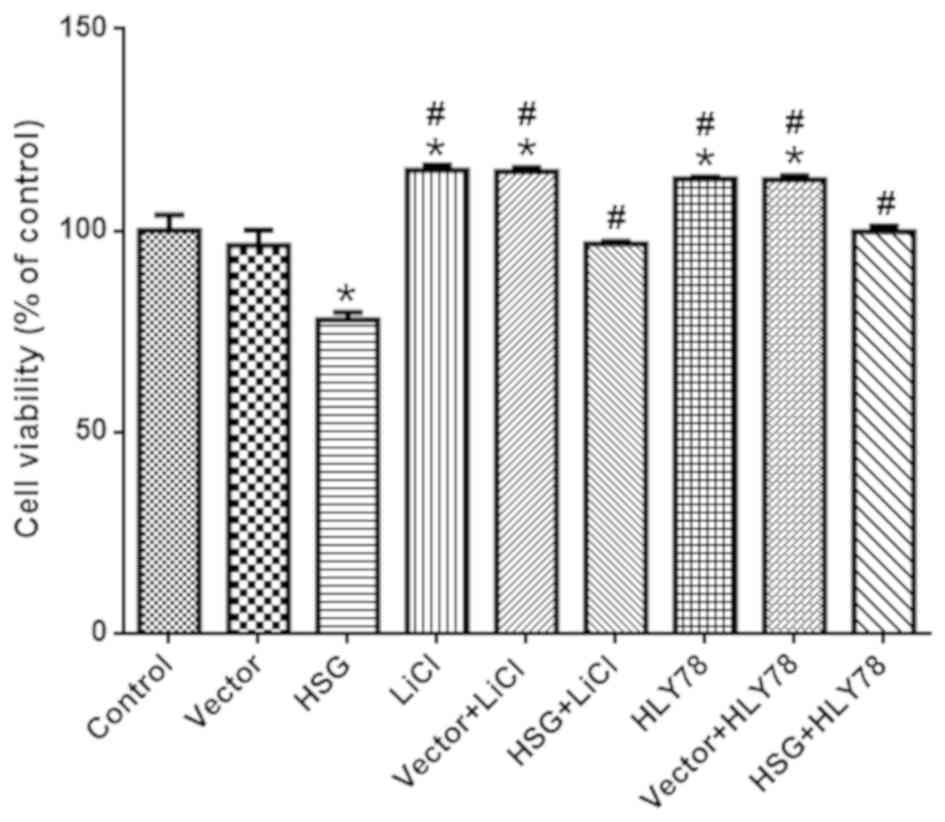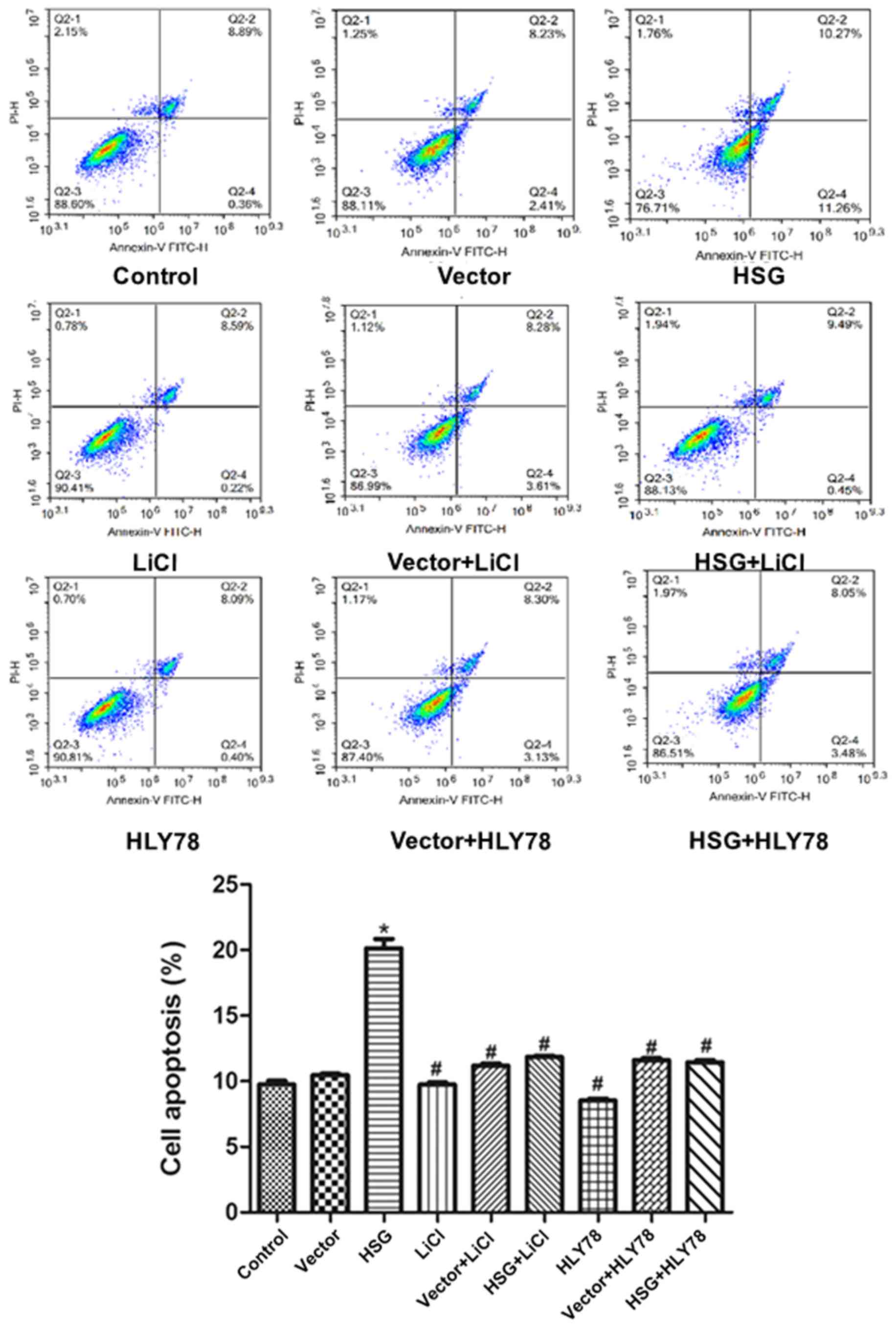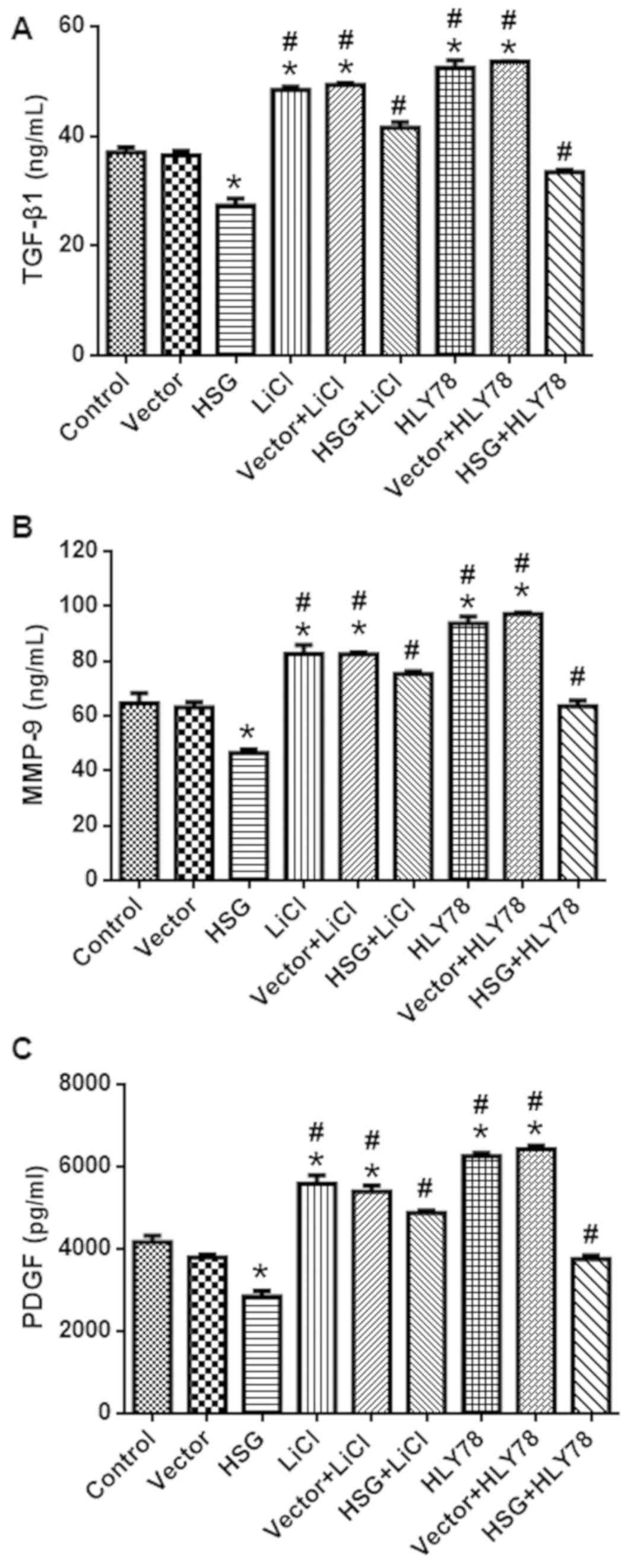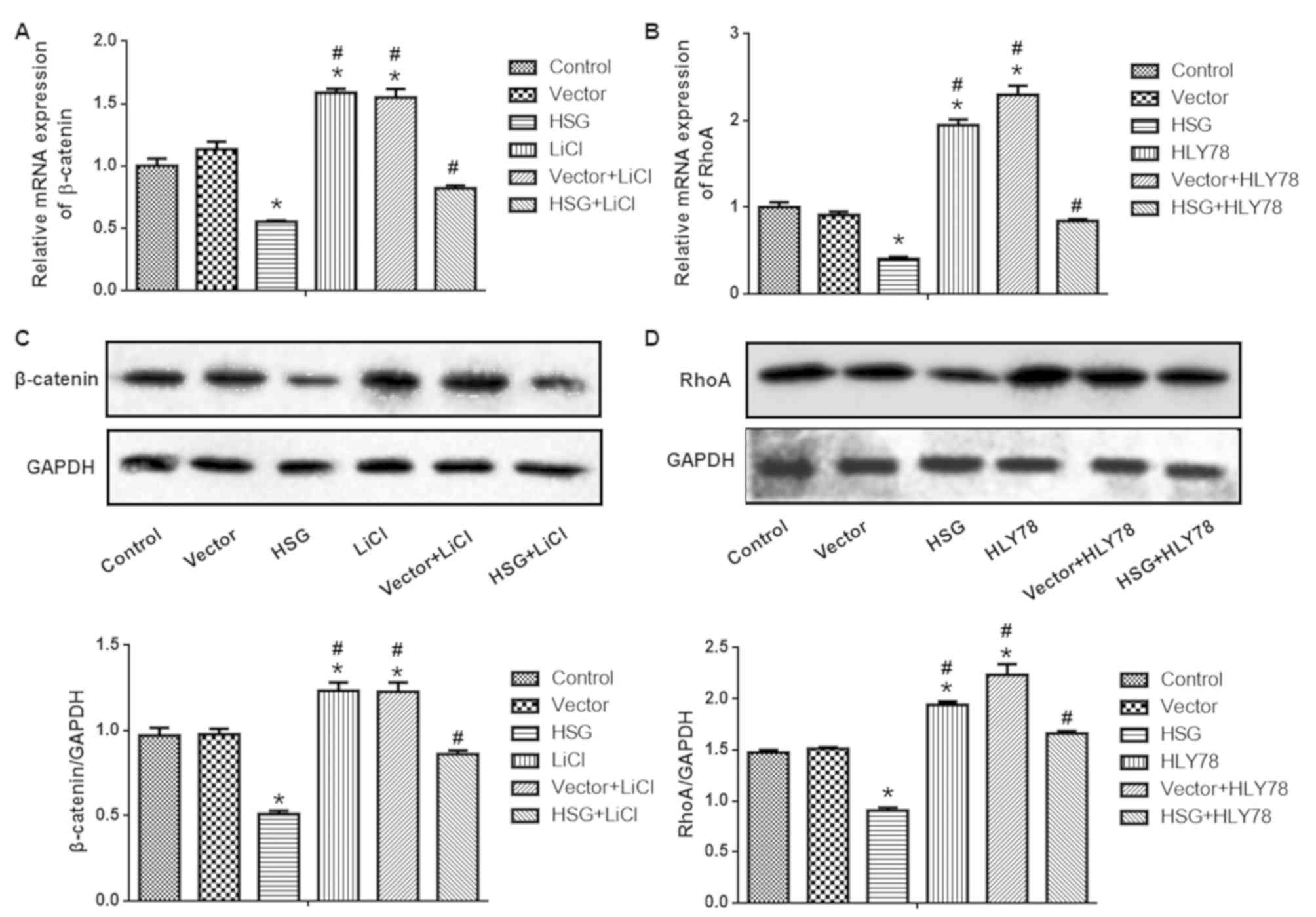Overexpression of the hyperplasia suppressor gene inactivates airway fibroblasts obtained from a rat model of chronic obstructive pulmonary disease by inhibiting the Wnt signaling pathway
- Authors:
- Published online on: July 15, 2019 https://doi.org/10.3892/mmr.2019.10504
- Pages: 2754-2762
-
Copyright: © Ge et al. This is an open access article distributed under the terms of Creative Commons Attribution License.
Abstract
Introduction
Chronic obstructive pulmonary disease (COPD) is a common respiratory disease characterized by incomplete reversibility of airflow obstruction. The pathological changes occurring in COPD include airway reconstruction and pulmonary artery reconstruction, particularly chronic bronchitis and emphysema (1). Airway remodeling is a key step in regulating disease progression, whereas uncontrollable activation of fibroblasts is central to airway reconstruction (1,2). As previously documented, factors including matrix metalloproteinase-9 (MMP-9), platelet-derived growth factor (PDGF) and transforming growth factor-β1 (TGF-β1) are notably involved in airway remodeling (3–5).
The hyperplasia suppressor gene (HSG) can inhibit cell proliferation and the cell cycle (6,7). HSG is reportedly highly expressed in normal cells, with reduced expression in proliferating cells (8–10). Overexpression of HSG can inhibit the malignant phenotype of breast cancer (11) and induce apoptosis in tumor cells (10). Of note, recombinant HSG can suppress the proliferation, and induce the apoptosis of airway fibroblasts (12); however, whether HSG is a suppressor of airway fibroblasts, and the underlying mechanisms involved in this process are yet to be verified.
The Wnt signaling pathway is involved not only in lung development, but also in the pathogenesis of pulmonary fibrosis (13), idiopathic pulmonary hypertension (14) and pulmonary interstitial disease (15). The Wnt/β-catenin signaling pathway is required for cell differentiation, apoptosis, carcinogenesis, immunity, and other physiological and pathological processes (16,17) and provides targets for the development of novel therapeutics to intervene with the development of COPD. The molecular mechanisms underpinning the pathogenesis of Wnt signaling components, including the destructive complex, in COPD are unclear (18); however, its role in cardiac and liver fibrosis has previously been explored (19,20). As both the HSG and Wnt signaling pathways contribute to fibrosis, it remains unclear whether HSG may regulate the Wnt/β-catenin signaling pathway in airway reconstruction. In the present study, an HSG overexpression vector was constructed to transfect airway fibroblasts in vitro to verify the effect of HSG overexpression on activation of airway fibroblasts, and assess the underlying mechanisms.
Materials and methods
Animals
A total of 20 male Sprague-Dawley rats (age, 3 months; body weight, 250 g) were purchased from Hunan Slake Jingda Laboratory Animal Co., Ltd. [license no. SCXK (Hunan) 2016-0002]. All animals were raised in non-toxic plastic boxes, stainless steel wire cages and metal cages, and housed in a specific pathogen-free environment that was automatically maintained at a temperature of 22±2°C and a relative humidity of 45–65%, under a controlled 12-h light/dark cycle with access to food and water ad libitum. All animal experiments were approved by the Ethics Committee of Guizhou College of Traditional Chinese Medicine (Guiyang, China).
Establishment of a rat model of COPD
Following anesthesia with sodium pentobarbital (40 mg/kg, intraperitoneal), rat skins were disinfected with iodophor. The epidermis and muscles along the middle of the neck were cut using surgical scissors to expose the trachea. Papain solution (2 mg/ml) was injected into the trachea at a dose of 1 ml/kg from top to bottom to reach the lungs. Subsequently, the animals were picked up and rotated to ensure that the drug had fully entered the trachea. Thereafter, the wound was sutured, and the animals were placed on an electric blanket. The animals were anesthetized with isoflurane (1% in oxygen) and decapitated 8 days after remodeling. Airway tissues from 3 animals were collected on ice and fixed in 4% paraformaldehyde overnight at 4°C. The tissues were sectioned into 5-µm thick sections and mounted on slides, followed by hematoxylin and eosin staining for 5 min at room temperature. The stained sections were observed under a light microscope (magnification: ×200; BX51; Olympus Corporation).
Preparation of airway fibroblasts
A total of 12 rats were sacrificed and thoracotomized under aseptic conditions to collect airway fibroblasts as previously described (21). A sterile scalpel was used to collect the tissue surrounding the airway; freshly obtained airway tissue from COPD rats was washed five times with phosphate-buffered saline (PBS) on an aseptic worktable. The tissue was then cut into 2×2-mm pieces using sterilized ophthalmic scissors. The tissue was pasted into the culture plate, and placed in a 5% CO2 incubator at 37°C for 4 h. After cell adherence, freshly prepared medium containing DMEM (Gibco; Thermo Fisher Scientific, Inc.) and 10% fetal bovine serum (FBS; cat. no. 04-007-1A; Biological Industries) was added to the culture plate, and the cells were further cultured in a 5% CO2 incubator at 37°C. Cell growth was monitored, the cell supernatant was periodically discarded, and newly prepared DMEM +10% FBS culture medium was added into the culture dish.
Immunohistochemistry
The cultured dishes (3×103/ml) were rinsed three times in PBS (3 min/wash), fixed in 4% paraformaldehyde for 15 min at room temperature, and permeated with 0.5% Triton X-100 PBS for 20 min at room temperature. Bovine serum albumin (5%; Gibco; Thermo Fisher Scientific, Inc.) was added to the culture dish, which was subsequently sealed at 37°C for 30 min. Anti-vimentin antibody (1:250; cat. no. ab92547; Abcam) was added to the dish and incubated at 37°C for 3 h. The diluted Cy3-conjugated secondary antibody (1:200, cat. no. BA1032, Wuhan Boster Biological Technology, Ltd.) was added and incubated at 37°C for 30 min. Subsequently, DAPI was used to stain the nuclei for 3 min at room temperature, and the images were observed under a fluorescence microscope (magnification: ×200) as previously described (22).
Reverse transcription-quantitative polymerase chain reaction (RT-qPCR)
Airway fibroblasts (3×103 cells/well) were seeded in 6-well plates. Following transfection and/or treatment, total mRNA was extracted using a TRIzol® assay kit (Baosheng Science & Technology Innovation Co. Ltd.). RNA quality was evaluated based on the optical density (260/280 nm). mRNA was transcribed into cDNA using a SMART® MMLV Reverse Transcriptase kit (cat. no. 639522; Takara Biotechnology Co., Ltd.) at 37°C using the following thermocycling conditions: 25°C for 10 min, 37°C for 120 min and 85°C for 5 min, which was subsequently used as the template for fluorescent qPCR. The reaction mixture included the following components: Deionized water (9.5 µl), cDNA (1 µl), primers (2 µl) and 2X UltraSYBR Mixture (12.5 µl; HY-K0501; MedChemExpress LLC) under the following cycling conditions: 35 cycles of 94°C denaturation for 45 sec, 59°C annealing for 45 sec and 72°C extension for 60 sec. The relative mRNA expression of HSG, β-catenin and Ras homology family member A (RhoA) was calculated using GAPDH as the reference using the 2−ΔΔCq method (23). The primers used in the study are presented in Table I.
Experimental groups
Airway fibroblasts were divided into nine groups: Control, vector, HSG overexpression (HSG), lithium chloride (LiCl), vector + LiCl, HSG + LiCl, 4-ethyl-5,6-dihydro-5-methyl-(1,3)dioxolo(4,5-j)phenanthridine (HLY78), vector + HLY78, and HSG + HLY78 (Fig. 1A). Wnt signaling pathway agonists, LiCl (cat. no. B6083) and HLY78 (cat. no. C5433) were purchased from Apexbio Technology, LLC. The cells were treated with either 10 mM LiCl or 10 µM HLY78 for 24 h, at 48 h at 37°C following transfection with the HSG vector.
Cell transfection
The HSG gene sequence (NM_130894) was obtained from the National Centre for Biotechnology Information database, and a biosynthetic gene fragment was cloned into the pCDNA3.1 (+) vector (Shanghai GenePharma Co. Ltd.) at the digestion site (Hind III/Xho I). Cells at 60% confluence were transfected with empty vector or HSG (1 µg/ml) using Lipofectamine® 3000 (Invitrogen; Thermo Fisher Scientific, Inc.). After 6 h, the medium was replaced with fresh DMEM containing 10% FBS and cultured in a 5% CO2 incubator at 37°C for 48 h. The cells were then used in the following experiments.
Cell Counting Kit-8 assay
After discarding the culture medium, the cells (3×105/ml) were washed with PBS and digested with trypsin for 2–3 min. Next, the cells were resuspended, inoculated into 96-well plates and placed in a 5% CO2 incubator at 37°C for 24 h. The assay was performed as previously described (24). The optical density was determined using a microplate reader (Bio-Tek Instruments, Inc.) at 570 nm to determine cell viability.
Flow cytometry
The cells (3×105/ml) were incubated in the dark with Annexin V-fluorescein isothiocyanate and propidium iodide (cat. no. AP101-100; Multisciences Biotech Co., Ltd.) for 30 min at room temperature. Subsequently, apoptosis was detected using a flow cytometer (BD Biosciences) within 1 h. Totally, four quadrants were divided based upon the fluorescence intensity and analyzed using FlowJo v10 (FlowJo, LLC). Quadrant Q2-2 was added to box quadrant Q2-4 to obtain the percentage of apoptotic cells.
ELISA
The cells were collected and total protein was isolated using a triple prep kit (cat. no. 28-9425-44, ReadyPrep; GE Healthcare Life Sciences). Protein concentration was measured using a bicinchoninic acid assay kit (cat. no. P0009: Beyotime Institute of Biotechnology). Volumes were adjusted to normalize the protein content, and then aliquots were processed for the ELISA using rat TGF-β1 (cat. no. MM-0181R1), rat MMP-9 (cat. no. MM-20918R1) and rat PDGF assay kits (cat. no. MM-0076R1; all MlBio; Shanghai Enzyme Biotechnology Co., Ltd.).
Western blot analysis
Following transfection and/or treatment as aforementioned, protein was extracted from each group using a protein isolation kit (cat. no. 28-9425-44; GE Healthcare Life Sciences). Protein levels were quantified with a bicinchoninic acid protein assay kit (cat. no. P0009; Beyotime Institute of Biotechnology). Proteins (25 µg/lane; 0.5 µg/µl) were separated via 12% SDS-PAGE and transferred onto polyvinylidene fluoride membranes. The membranes were blocked in 5% skimmed milk for 2 h at room temperature and incubated with the following primary antibodies overnight at 4°C: Mouse monoclonal anti-GAPDH (1:2,000; cat. no. TA-08; OriGene Technologies, Inc.); rabbit polyclonal anti-HSG (1:5,000; cat. no. ab124773; Abcam); rabbit polyclonal anti-β-catenin (1:300; cat. no. ab32572; Abcam) and rabbit polyclonal anti-RhoA (1:2,000; cat. no. ab187026; Abcam). The IgG horseradish peroxidase-conjugated secondary antibody (mouse: 1:100; cat. no. ab131368; Abcam; rabbit: 1:100; ZB-2301; OriGene Technologies, Inc.) was added and co-incubated for 2 h at room temperature. An enhanced chemiluminescence exposure liquid droplet (cat. no. RJ239676; Thermo Fisher Scientific, Inc.) was added to the membranes. The membranes were visualized using a gel imaging system (Bio-Rad Laboratories, Inc.). Densitometry was performed using Quantity One version 1.4.6 (Bio-Rad Laboratories, Inc.).
Statistical analysis
Data were presented as the mean ± standard error of the mean with 6 independent repeats and analyzed using SPSS version 17.0 (SPSS, Inc.). Significant differences were determined using one-way analysis of variance, followed by the Student-Newman-Keuls post hoc test. P<0.05 was considered to indicate a statistically significant difference.
Results
HSG overexpression reduces the viability of airway fibroblasts
The airway tissue of the control group exhibited regular alveolar structure (Fig. 1B). Pathological expansion and fusion of alveolar cavities were not observed. The wall of the bronchial tube was normal, the epithelium of the airway mucosa was smooth, cilia were neatly arranged, and obvious inflammatory exudation was not found in the tracheal cavity. In contrast, the airway tissue of the COPD group showed evidence of emphysema, alveolar dilatation, an alveolar wall that disintegrated and fused to form lung ulcers, and markedly decreased numbers of alveoli (Fig. 1B). The goblet cells of the bronchial epithelium showed proliferation, and a number of inflammatory cells such as neutrophils and giant cells infiltrated the lumen, accompanied by the proliferation of fibrous connective tissue.
The identification of airway fibroblasts is shown in Fig. 1C, wherein red indicates vimentin expression, and nuclear staining by DAPI is observed in blue. All cells showed vimentin expression, indicating successful preparation of the airway fibroblasts. Compared with the vector group, the HSG vector upregulated HSG expression at both the mRNA and protein levels (both P<0.05; Fig. 2A and B), whereas the control vector did not influence HSG expression. Thereafter, the effects of HSG overexpression on cell viability were measured. The cell viability of the HSG group was decreased (vs. vector, P<0.05), which was inhibited by HLY78 and LiCl (vs. HSG, P<0.05; Fig. 3). Of note, LiCl and HLY78 alone increased cell viability (vs. control, P<0.05).
HSG overexpression facilitates apoptosis of airway fibroblasts
To further examine the effects of HSG overexpression on apoptosis, flow cytometry was used to detect the cell distribution following double staining. The apoptosis rate in the HSG group was significantly higher compared with that observed in the vector group (P<0.05; Fig. 4). LiCl and HLY78 reduced the effects of HSG overexpression on apoptosis (vs. HSG, P<0.05). The rates of apoptosis in the HSG + LiCl and HSG + HLY78 groups were significantly lower compared with that detected in the HSG group (P<0.05). However, LiCl and HLY78 alone did not affect apoptosis (vs. control, P>0.05; Fig. 4).
HSG overexpression reduces the levels of TGF-β1, MMP-9, and PDGF
The protein levels of TGF-β1, MMP-9, and PDGF in each group are shown in Fig. 5. The levels of TGF-β1 (Fig. 5A), MMP-9 (Fig. 5B), and PDGF (Fig. 5C) in the HSG group were decreased compared with in the control group. In contrast, these levels were higher in the HSG + LiCl and HSG + HLY78 groups compared with the HSG group (P<0.05). LiCl and HLY78 alone also increased the levels of TGF-β1, MMP-9, and PDGF (vs. control; P<0.05).
HSG overexpression reduces the expression of β-catenin and RhoA
The expression of β-catenin and RhoA in each group was normalized to GAPDH and is presented in Fig. 6. The mRNA levels of β-catenin (Fig. 6A) and RhoA (Fig. 6B) were higher in the HSG group compared with the vector group (both P<0.05). However, the expression of β-catenin and RhoA was reduced by LiCl and HLY78, respectively (vs. HSG, P<0.05). The protein expression of β-catenin (Fig. 6C) and RhoA (Fig. 6D) was also detected using western blot analysis. Consistent with the mRNA expression, the protein levels of β-catenin and RhoA (normalized to GAPDH) in the HSG group were higher (vs. control, P<0.05), and the expression of β-catenin and RhoA was reduced by LiCl and HLY78, respectively (vs. HSG, P<0.05). The expression of β-catenin and RhoA was promoted by LiCl and HLY78 alone, respectively (vs. control, P<0.05).
Discussion
Although the effects of HSG on tumors are well documented (10,11), the role of HSG in airway fibroblast proliferation in COPD remains unknown. The present study demonstrated that HSG overexpression reduced cell viability and facilitated the apoptosis of airway fibroblasts in a rat model of COPD. This mechanism involved inactivation of the Wnt signaling pathway. These data may have important implications for the treatment of airway remodeling in the future.
The pathogenesis of COPD is closely associated with factors, including smoking, exposure to air pollution and inhalation of dust (25,26). Pathological changes observed in COPD include chronic bronchitis, emphysema, airway reconstruction and pulmonary artery reconstruction (27). In the present study, the alveolar wall became thinner, the number of alveolar septa was markedly reduced, the alveolar cavity was enlarged and ruptured, and lung ulcers formed following inhalation of papain. A previous study reported that exogenous recombinant HSG may inhibit cell proliferation and airway reconstruction (12). In the present study, it was further reported that an exogenous HSG vector may reduce the viability, and promote the apoptosis of airway fibroblasts. Collectively, these studies indicated the importance of HSG as a potential target for the treatment of airway remodeling in patients with COPD.
In the respiratory system, the Wnt signaling pathway participates in the development of lung tissue and is involved in pulmonary fibrosis (28). In the present study, activators of the Wnt/β-catenin signaling pathways were used to confirm the role of these pathways in the HSG-induced decrease in cell viability and increase in apoptosis. These results further indicated that Wnt signaling is involved in airway remodeling of COPD (29–32).
TGF-β1 is a known target of the Wnt pathway and a multifunctional protein (33). It plays a role in cell growth, differentiation, apoptosis, and regulation of the immune system (34–36). TGF-β1 is widely distributed in the trachea and bronchus, and found in infiltrating neutrophils, macrophages, and airway fibroblasts during the progression of COPD (37). It is the most important fibrogenic cytokine and can reverse-regulate and stimulate fibroblasts to synthesize and secrete components of the extracellular matrix, leading to airway fibrosis (38–40). In the pathogenesis of COPD, MMP-9 mainly functions by degrading extracellular components of the alveolar matrix and aggravating alveolar cavity expansion, thereby resulting in decreased elasticity and low retraction (41). On the other hand, MMP-9 is involved in airway remodeling by destroying epithelial and endothelial cells (42). In addition, MMP-9 is a target of the Wnt pathway (30,43). PDGF can stimulate the chemotaxis and proliferation of airway fibroblasts and extracellular matrix synthesis, one of the mechanisms of airway reconstruction (44). The results from the present study showed that HSG regulates the expression of TGF-β1, MMP-9 and PDGF. Additionally, the expression of these factors was regulated by the Wnt/β-catenin and Wnt/PCP signaling pathways. These results suggested that HSG may interfere with airway remodeling in COPD.
Additionally, HSG can inhibit the expression of MMP-9, PDGF, TGF-β1 in fibroblasts, thus inhibiting airway remodeling (45). These regulatory effects are mediated by the Wnt signaling pathway. In the present study HSG was negatively associated with the Wnt/β-catenin and Wnt/PCP signaling pathways, which further confirmed the association between HSG and the Wnt signaling pathway. It can be concluded that HSG inhibits the proliferation of airway fibroblasts by inhibiting the abnormal activation of the Wnt signaling pathway. Therefore, the promotion of HSG expression, or inhibition of abnormal activation of the Wnt/PCP signaling pathway to inhibit the overexpression of MMP-9, PDGF and TGF-β1, may be an effective therapeutic strategy for airway remodeling in COPD. Although HSG overexpression inactivated the Wnt signaling pathway, the specific mechanisms could not be verified. A previous study demonstrated that PTEN, another tumor suppressor gene, interacts with Wnt1 to regulate the Wnt signaling pathway (46). Whether HSG is directly or indirectly linked to the Wnt signaling pathway requires further investigation.
The present study has certain limitations. First, the majority of the experiments were conducted in the cellular model, although airway fibroblasts were collected from COPD rats. In vivo experiments are required to confirm the present results. Second, an association was established between HSG and the Wnt signaling pathway in apoptosis; however, the exact mechanism of regulation requires further investigation. In addition, the contribution of autophagy and other types of cell death should also be determined in future studies.
In conclusion, our data demonstrated that HSG overexpression inactivates airway fibroblasts via regulation of the Wnt signaling pathway. This may represent a potential therapeutic target for COPD.
Acknowledgements
Not applicable.
Funding
The present study was supported by the National Natural Science Foundation of China (grant no. 81473533) and the Major Basic Research in Guizhou Province [grant no. (2015) 2002].
Availability of data and materials
The datasets used during the present study are available from the corresponding author upon reasonable request.
Authors' contributions
ZG and YY conceived and designed the experiments; ZG, YY, XZ, JZ, BL, XW and XL performed the experiments and analyzed the data; ZG and YY wrote the manuscript. All authors read and approved the manuscript and agree to be accountable for all aspects of the research in ensuring that the accuracy or integrity of any part of the work are appropriately investigated and resolved.
Ethics approval and consent to participate
All animal experiments were approved by the Ethics Committee of Guizhou College of Traditional Chinese Medicine (Guiyang, China).
Patient consent for publication
Not applicable.
Competing interests
The authors declare that they have no competing interests.
References
|
Yu ZW, Xu YQ, Zhang XJ, Pan JR, Xiang HX, Gu XH, Ji SB and Qian J: Mutual regulation between miR-21 and the TGFβ/Smad signaling pathway in human bronchial fibroblasts promotes airway remodeling. J Asthma. 56:341–349. 2019. View Article : Google Scholar : PubMed/NCBI | |
|
Lai T, Tian B, Cao C, Hu Y, Zhou J, Wang Y, Wu Y, Li Z, Xu X, Zhang M, et al: HDAC2 suppresses IL17A-mediated airway remodeling in human and experimental modeling of COPD. Chest. 153:863–875. 2018. View Article : Google Scholar : PubMed/NCBI | |
|
Ricciardolo FLM, Folkerts G, Folino A and Mognetti B: Bradykinin in asthma: Modulation of airway inflammation and remodelling. Eur J Pharmacol. 827:181–188. 2018. View Article : Google Scholar : PubMed/NCBI | |
|
Eapen MS, Myers S, Lu W, Tanghe C, Sharma P and Sohal SS: sE-cadherin and sVE-cadherin indicate active epithelial/endothelial to mesenchymal transition (EMT and EndoMT) in smokers and COPD: Implications for new biomarkers and therapeutics. Biomarkers. 23:709–711. 2018. View Article : Google Scholar : PubMed/NCBI | |
|
Mahmood MQ, Reid D, Ward C, Muller HK, Knight DA, Sohal SS and Walters EH: Transforming growth factor (TGF) β1 and Smad signalling pathways: A likely key to EMT-associated COPD pathogenesis. Respirology. 22:133–140. 2017. View Article : Google Scholar : PubMed/NCBI | |
|
Sun ZQ, Chen G, Guo Q, Li HF and Wang Z: In vivo and in vitro effects of hyperplasia suppressor gene on the proliferation and apoptosis of lung adenocarcinoma A549 cells. Biosci Reports. 38:BSR201803912018. View Article : Google Scholar | |
|
Luo L, Gong YQ, Qi X, Lai W, Lan H and Luo Y: Effect of tumor suppressor PTEN gene on apoptosis and cell cycle of human airway smooth muscle cells. Mol Cell Biochem. 375:1–9. 2013.PubMed/NCBI | |
|
Jiang GJ, Han M, Zheng B and Wen JK: Hyperplasia suppressor gene associates with smooth muscle alpha-actin and is involved in the redifferentiation of vascular smooth muscle cells. Heart Vessels. 21:315–320. 2006. View Article : Google Scholar : PubMed/NCBI | |
|
Guo YH, Li Q, Yu HY and Gao W: Hyperplasia suppressor gene induces vascular smooth muscle cell apoptosis. Beijing Da Xue Xue Bao Yi Xue Ban. 39:394–398. 2007.(In Chinese). PubMed/NCBI | |
|
Wu L, Li Z, Zhang Y, Zhang P, Zhu X, Huang J, Ma T, Lu T, Song Q, Li Q, et al: Adenovirus-expressed human hyperplasia suppressor gene induces apoptosis in cancer cells. Mol Cancer Ther. 7:222–232. 2008. View Article : Google Scholar : PubMed/NCBI | |
|
Zhang Y, Du Q, Qiu XY, Tian XX and Fang WG: Over expression of hyperplasia suppressor gene inhibits the malignant phenotype of breast cancer cell. Zhonghua Bing Li Xue Za Zhi. 39:259–263. 2010.(In Chinese). PubMed/NCBI | |
|
Zheng-Xing GE, Bo LI, Zhou X and Chang LI: rHSG gene regulates airway fibroblast proliferation and apoptosis of COPD rats. Basic Clin Med. 33:1235–1241. 2013. | |
|
Villar J, Cabrera NE, Valladares F, Casula M, Flores C, Blanch L, Quilez ME, Santana-Rodríguez N, Kacmarek RM and Slutsky AS: Activation of the Wnt/β-catenin signaling pathway by mechanical ventilation is associated with ventilator-induced pulmonary fibrosis in healthy lungs. PLoS One. 6:e239142011. View Article : Google Scholar : PubMed/NCBI | |
|
Chilosi M, Poletti V, Zamò A, Lestani M, Montagna L, Piccoli P, Pedron S, Bertaso M, Scarpa A, Murer B, et al: Aberrant Wnt/beta-catenin pathway activation in idiopathic pulmonary fibrosis. Am J Pathol. 162:1495–1502. 2003. View Article : Google Scholar : PubMed/NCBI | |
|
Königshoff M, Balsara N, Pfaff EM, Kramer M, Chrobak I, Seeger W and Eickelberg O: Functional Wnt signaling is increased in idiopathic pulmonary fibrosis. PLoS One. 3:e21422008. View Article : Google Scholar : PubMed/NCBI | |
|
Peng Y, Zhang X, Ma Q, Yan R, Qin Y, Zhao Y, Cheng Y, Yang M, Wang Q, Feng X, et al: MiRNA-194 activates the Wnt/β-catenin signaling pathway in gastric cancer by targeting the negative Wnt regulator, SUFU. Cancer Lett. 385:117–127. 2017. View Article : Google Scholar : PubMed/NCBI | |
|
Clevers H and Nusse R: Wnt/β-catenin signaling and disease. Cell. 149:1192–1205. 2012. View Article : Google Scholar : PubMed/NCBI | |
|
Qu J, Yue L, Gao J and Yao H: Perspectives on Wnt signal pathway in the pathogenesis and therapeutics in chronic obstructive pulmonary disease. J Pharmacol Exp Ther. 369:473–480. 2019. View Article : Google Scholar : PubMed/NCBI | |
|
Tao H, Yang JJ, Shi KH and Li J: Wnt signaling pathway in cardiac fibrosis: New insights and directions. Metabolism. 65:30–40. 2016. View Article : Google Scholar : PubMed/NCBI | |
|
Nishikawa K, Osawa Y and Kimura K: Wnt/β-catenin signaling as a potential target for the treatment of liver cirrhosis using antifibrotic drugs. Int J Mol Sci. 19:E31032018. View Article : Google Scholar : PubMed/NCBI | |
|
Lewis CC, Chu HW, Westcott JY, Tucker A, Langmack EL, Sutherland ER and Kraft M: Airway fibroblasts exhibit a synthetic phenotype in severe asthma. J Allergy Clin Immunol. 115:534–540. 2005. View Article : Google Scholar : PubMed/NCBI | |
|
Song Z, Chen H, Xu W, Wu S and Zhu G: Basolateral amygdala calpain is required for extinction of contextual fear-memory. Neurobiol Learn Mem. 155:180–188. 2018. View Article : Google Scholar : PubMed/NCBI | |
|
Livak KJ and Schmittgen TD: Analysis of relative gene expression data using real-time quantitative PCR and the 2(-Delta Delta C(T)) method. Methods. 25:402–408. 2001. View Article : Google Scholar : PubMed/NCBI | |
|
Zhu G, Wang X, Wu S and Li Q: Involvement of activation of PI3K/Akt pathway in the protective effects of puerarin against MPP+-induced human neuroblastoma SH-SY5Y cell death. Neurochem Int. 60:400–408. 2012. View Article : Google Scholar : PubMed/NCBI | |
|
Aigon A and Billecocq S: Prevalence and impact on quality of life of urinary incontinence in an adult population with chronic obstructive pulmonary diseases, literature review. Prog Urol. 28:962–972. 2018.(In French). View Article : Google Scholar : PubMed/NCBI | |
|
Oshagbemi OA, Keene SJ, Driessen JHM, Jordan R, Wouters EFM, de Boer A, de Vries F and Franssen FME: Trends in moderate and severe exacerbations among COPD patients in the UK from 2005 to 2013. Respir Med. 144:1–6. 2018. View Article : Google Scholar : PubMed/NCBI | |
|
Moon JY, Leitao Filho FS, Shahangian K, Takiguchi H and Sin DD: Blood and sputum protein biomarkers for chronic obstructive pulmonary disease (COPD). Expert Rev Proteomics. 15:923–935. 2018. View Article : Google Scholar : PubMed/NCBI | |
|
Reuter S, Beckert H and Taube C: Take the Wnt out of the inflammatory sails: Modulatory effects of Wnt in airway diseases. Lab Invest. 96:177–185. 2016. View Article : Google Scholar : PubMed/NCBI | |
|
Bartel S, Carraro G, Alessandrini F, Krauss-Etschmann S, Ricciardolo FLM and Bellusci S: miR-142-3p is associated with aberrant WNT signaling during airway remodeling in asthma. Am J Physiol Lung Cell Mol Physiol. 315:L328–L333. 2018. View Article : Google Scholar : PubMed/NCBI | |
|
Royer PJ, Henrio K, Pain M, Loy J, Roux A, Tissot A, Lacoste P, Pison C, Brouard S and Magnan A; COLT consortium, : TLR3 promotes MMP-9 production in primary human airway epithelial cells through Wnt/β-catenin signaling. Respir Res. 18:2082017. View Article : Google Scholar : PubMed/NCBI | |
|
Koopmans T and Gosens R: Revisiting asthma therapeutics: Focus on WNT signal transduction. Drug Discov Today. 23:49–62. 2018. View Article : Google Scholar : PubMed/NCBI | |
|
Hussain M, Xu C, Lu M and Wu X, Tang L and Wu X: Wnt/β-catenin signaling links embryonic lung development and asthmatic airway remodeling. Biochim Biophys Acta Mol Basis Dis. 1863:3226–3242. 2017. View Article : Google Scholar : PubMed/NCBI | |
|
Vallée A, Lecarpentier Y, Guillevin R and Vallée JN: Interactions between TGF-β1, canonical WNT/β-catenin pathway and PPAR γ in radiation-induced fibrosis. Oncotarget. 8:90579–90604. 2017. View Article : Google Scholar : PubMed/NCBI | |
|
Si Y, Bai J, Wu J, Li Q, Mo Y, Fang R and Lai W: LncRNA PlncRNA1 regulates proliferation and differentiation of hair follicle stem cells through TGFbeta1mediated Wnt/betacatenin signal pathway. Mol Med Rep. 17:1191–1197. 2018.PubMed/NCBI | |
|
Ma F, Li W, Liu C, Li W, Yu H, Lei B, Ren Y, Li Z, Pang D and Qian C: MiR-23a promotes TGF-β1-induced EMT and tumor metastasis in breast cancer cells by directly targeting CDH1 and activating Wnt/β-catenin signaling. Oncotarget. 8:69538–69550. 2017.PubMed/NCBI | |
|
Li M, Yuan Y, Chen Q, Me R, Gu Q, Yu Y, Sheng M and Ke B: Expression of Wnt/β-catenin signaling pathway and its regulatory role in type I collagen with TGF-β1 in scleral fibroblasts from an experimentally induced myopia guinea pig model. J Ophthalmol. 2016:51265602016.PubMed/NCBI | |
|
Godinas L, Corhay JL, Henket M, Guiot J, Louis R and Moermans C: Increased production of TGF-β1 from sputum cells of COPD: Relationship with airway obstruction. Cytokine. 99:1–8. 2017. View Article : Google Scholar : PubMed/NCBI | |
|
Westergren-Thorsson G, Bagher M, Andersson-Sjoland A, Andersson-Sjöland A, Thiman L, Löfdahl CG, Hallgren O, Bjermer L and Larsson-Callerfelt AK: VEGF synthesis is induced by prostacyclin and TGF-beta in distal lung fibroblasts from COPD patients and control subjects: Implications for pulmonary vascular remodelling. Respirology. 23:68–75. 2018. View Article : Google Scholar : PubMed/NCBI | |
|
Chen H, Zhang R, Zheng Q, Yan X, Wu S and Chen Y: Impact of body mass index on long-term blood pressure variability: A cross-sectional study in a cohort of Chinese adults. BMC Public Health. 18:11932018. View Article : Google Scholar : PubMed/NCBI | |
|
Di Stefano A, Sangiorgi C, Gnemmi I, Casolari P, Brun P, Ricciardolo FLM, Contoli M, Papi A, Maniscalco P, Ruggeri P, et al: TGF-β signaling pathways in different compartments of the lower airways of patients with stable COPD. Chest. 153:851–862. 2018. View Article : Google Scholar : PubMed/NCBI | |
|
Zhdan VN, Potyazhenko MМ, Khaymenova GS, Lyulka NN, Dubrovinskaya TV and Ivanitsky IV: Intensifying approach to the therapy of patients with constellation of the diseases: Chronic obstructive pulmonary disease and osteoarthritis. Wiad Lek. 70:578–580. 2017.PubMed/NCBI | |
|
Zhao Y, Qiao X, Wang L, Tan TK, Zhao H, Zhang Y, Zhang J, Rao P, Cao Q, Wang Y, et al: Matrix metalloproteinase 9 induces endothelial-mesenchymal transition via Notch activation in human kidney glomerular endothelial cells. BMC Cell Biol. 17:212016. View Article : Google Scholar : PubMed/NCBI | |
|
Yang Z, Li K, Liang Q, Zheng G, Zhang S, Lao X, Liang Y and Liao G: Elevated hydrostatic pressure promotes ameloblastoma cell invasion through upregulation of MMP-2 and MMP-9 expression via Wnt/β-catenin signalling. J Oral Pathol Med. 47:836–846. 2018. View Article : Google Scholar : PubMed/NCBI | |
|
Lu J, Zhu Y, Feng W, Pan Y, Li S, Han D, Liu L, Xie X, Wang G and Li M: Platelet-derived growth factor mediates interleukin-13-induced collagen I production in mouse airway fibroblasts. J Biosci. 39:693–700. 2014. View Article : Google Scholar : PubMed/NCBI | |
|
Song S, Zhang M, Yi Z, Zhang H, Shen T, Yu X, Zhang C, Zheng X, Yu L, Ma C, et al: The role of PDGF-B/TGF-β1/neprilysin network in regulating endothelial-to-mesenchymal transition in pulmonary artery remodeling. Cell Signal. 28:1489–1501. 2016. View Article : Google Scholar : PubMed/NCBI | |
|
Zhao H, Cui Y, Dupont J, Sun H, Hennighausen L and Yakar S: Overexpression of the tumor suppressor gene phosphatase and tensin homologue partially inhibits wnt-1-induced mammary tumorigenesis. Cancer Res. 65:6864–6873. 2005. View Article : Google Scholar : PubMed/NCBI |



